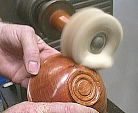100mm (4″) x 50 fold mop: Ideal for static buffing of small size to medium items. Bowls, platters, carved pieces and other hand held objects. CAUTION: Not recommended for use in drill as drill head may easily come in contact with and damage the work.
150mm (6″) x 75 fold mop: Ideal for static buffing and use in a drill good for buffing of larger size items. Jewellery boxes, small pieces of furniture, coffee tables etc. WARNING: If used on lathe or other static item beware of catches on the end of work piece as this can strip the work out of your hands and sent it flying.
150mm (6″) x 100 fold mop: Ideal for use an electric or compressed air drill. Excellent for most large items, table tops, bench tops, cabinets, etc. Can be used, but not ideal for static buffing. WARNING: If used for static buffing the wide face of the buff can very easily strip the work from your hands and send it flying.
These genuine Swansdown Mops are made right here in Australia and are one of the best ways we have found to put a brilliant wax finish onto timber especially if you are using our EEE-Ultra Shine, Traditional Wax or both. They also work extremely well with Shellawax and Shellawax Cream.
Using one of these mops can cut the time it takes to buff a wax finish to a matter of seconds, depending upon the size of the work to be buffed. A tabletop will only take an couple of minutes easy work with the 100 fold buff compared to around 15 minutes or more of arm wrenching, back aching hand rubbing. It will leave a much nicer shine on the timber because it is working with the grain rather than putting swirls on the surface that you would get from using a lambs-wool buff, which works with a circular motion. These mops also work much cooler than a lambs-wool buff in a drill or angle grinder, making them much safer to use on surfaces that may be effected by heat.

Contrary to popular belief: These mops, although called Swansdown are actually made from the finest quality, high thread count flannel for long life and have the softness of genuine swansdown. The flannel is woven to form a soft fabric sheet of material called a folds these sheets are put together in a stack of 50, 75, or 100, cut to size, securely fastened between two heavy washers and finally the centre hole is punched out.
The photo to the left shows the 150mm (6″) x 100 fold mop being used with a drill. It is ideal for buffing large areas as it spreads to around 115mm (4.5″) across its buffing surface when in use, making it easy to cover a large area with each pass. A tabletop with a width of 1 metre can easily be buffed in no more than 10 – 12 passes of the mop the 100mm (4″) diameter x 50 fold 150mm (6″) x 75 fold, and 150mm x 100 fold.
|
SWANSDOWN BUFF ON THE LATHE |
|||
|
|||
| Above and below the mop is attached to the lathe via a long coach bolt which fits snugly through a timber cone and then into a screw chuck. This same fixing could be used with a faceplate, scroll chuck and other chucks. |
|||
|
|||
|
On the lathe the 100mm x 50 fold mop can be used both inside & out on bowls, is ideal for buffing work that cant be finished on the lathe as well as small boxes, jewellery, carvings and more. Excellent for restoring beautiful lustre after to work after constant handling when displayed in a shop or just neglected.. |
THREE IDEAS FOR USING THE SWANSDOWN MOP
These buffs can be used on the lathe or on a bench grinder for static buffing, as shown in all the above photos. They can also be used in a drill for working on flat surfaces that can’t be buffed on a static buffing setup.



The first 2 illustrations above left show how to mount the buffs on the lathe and bench grinder for static buffing. The third shows how to mount a buff for use with a drill. As in the first photo on this page.
When these mops are new they will shed a lot of fluff the first few times they are used, to minimize and control this shedding it is a good idea to condition the mop before using it. This is done by running the mop at high speed then putting a piece of very course abrasive (16 grit is ideal) in contact with the edge of the mop that is used for buffing. This will drag off any of the loose fibres with a controlled action. This can also be done using a hacksaw blade and a bit of care. If possible do it outside with the wind to your back or set up a fan behind you or you will be covered from head to toe in white fluff.
Wear a dust mask, goggles or face shield, old cloths or overalls, etc.






